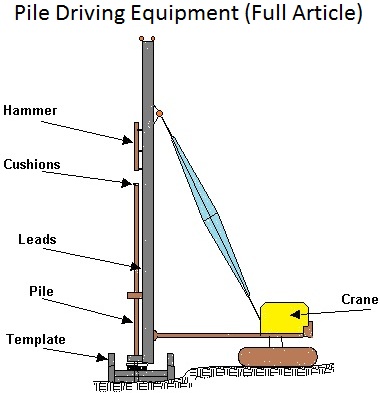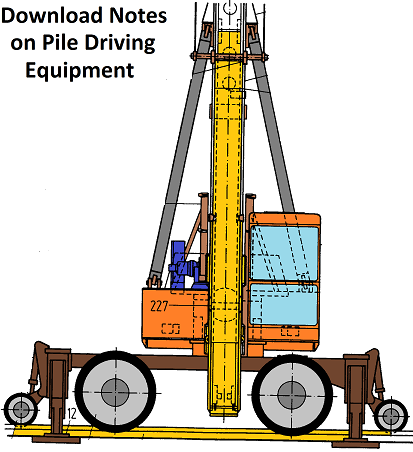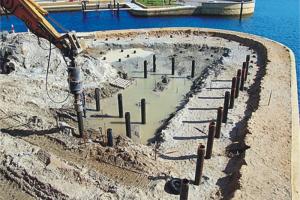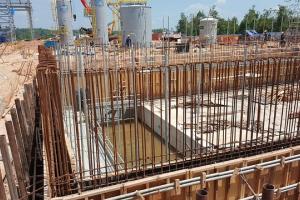Pile Driving Equipment - Pile Hammers
Pile Driving Equipment:
Pile Foundations are installed by a special pile driving device known as a pile hammer. The hammer may be suspended from the boom of a crawler crane, supported on a large frame called a pile driver or carried on a barge for construction in water. In all cases, the hammer is guided between two parallel steel members called leads. The leads may be adjusted at various angles for driving vertical and batter piles.
Also See: Types of Piles
Types of Hammer:
Several types of hammers are in use and each of which are different sizes. The hammer types are:
1. Drop hammer:
The drop hammer in the  pile driving equipment consists of a heavy ram in between the leads. The ram is lifted up to a certain height and released to drop on the pile. This type is slow and therefore not in common use. It is used in the cases where only a small number of piles are driven.
pile driving equipment consists of a heavy ram in between the leads. The ram is lifted up to a certain height and released to drop on the pile. This type is slow and therefore not in common use. It is used in the cases where only a small number of piles are driven.
2. Single acting hammer:
In a single acting hammer a heavy ram is lifted up by steam or compressed air but dropped by its own weight. The energy of a single acting hammer is equal to the weight of the ram times the height of fall.
3. Double-acting hammer:
The double-acting hammer employs steam or air for lifting the ram and for accelerating the downward stroke. The energy of a double-acting hammer is equal to the (weight of the ram I mean effective pressure I the effective area of ram) 1 times the height of fall.
4. Diesel hammer:
 The diesel hammer is a small, light weight and highly mobile. They use gasoline for fuel. To start the operation, the ram is raised, and the fuel is injected. As the ram is released, the ram falls and compresses air and fuel. The air and fuel becomes hot because of the compression and the air-fuel mixture is ignited. The resulting explosion
The diesel hammer is a small, light weight and highly mobile. They use gasoline for fuel. To start the operation, the ram is raised, and the fuel is injected. As the ram is released, the ram falls and compresses air and fuel. The air and fuel becomes hot because of the compression and the air-fuel mixture is ignited. The resulting explosion
- Advances the pile and
- Lifts the ram. If the pile advance is very great as in soft soils, the ram is not lifted by the explosion sufficiently to ignite the air-fuel mixture on the next cycic, requiring that the ram be again manually lifted.
5. Vibratory hammer:
The principle of the vibratory driver is two counter-rotating eccentric weights. The driving unit vibrates at high frequency and provides two vertical impulses, one up and one down. The downward pulse acts with the pile weight to increase the apparent gravity force. These hummers have reduced driving vibrations, reduced noise, and great speed of penetration.
Hammer Selection:
Generally the size of hammer is more important factor than type of hammer. A heavy pile should be driven by a heavy hammer delivering large energy. Preferably the weight of HKjmcr should beat ^H HB1 the total weight of the pile and the deriving energy should be at Hpiie foot-pound for each pound of pile weight. Each type of hammer has its use under suitable conditions, The advantages and disadvantages of cach type are summarized below:
Single-acting hammer :
They arc advantageous when driving heavy piles in compact or hard soils; the heavy ram striking at - tow velocity produces least damage due to impact. The disadvantages arc low driving speed and large headroom requirement.
Double-acting hammer:
They are generally used to drive piles of light or moderate weight in soils of average resistance against driving. This type of hammer can drive piles at fast speed, requires less headroom and can be used to extract piles by turning them [i.e. the double-acting hammer] upside down.
Diesel hammer:
They are similar in application as double-acting hammers, but driving may become difficult in extremely soft ground.
Vibratory hammer:
They have fairly good results in silty and clayey deposits. They are used in heavy clays or soils with appreciable numbers of boulders. See above for other advantages.
| Hammer Type |
Efficiency (ɳh) |
| Single and double acting hammer | 0.7 - 0.85 |
| Diesel hammers | 0.8 - 0.9 |
| Drop hammers | 0.7 - 0.9 |









